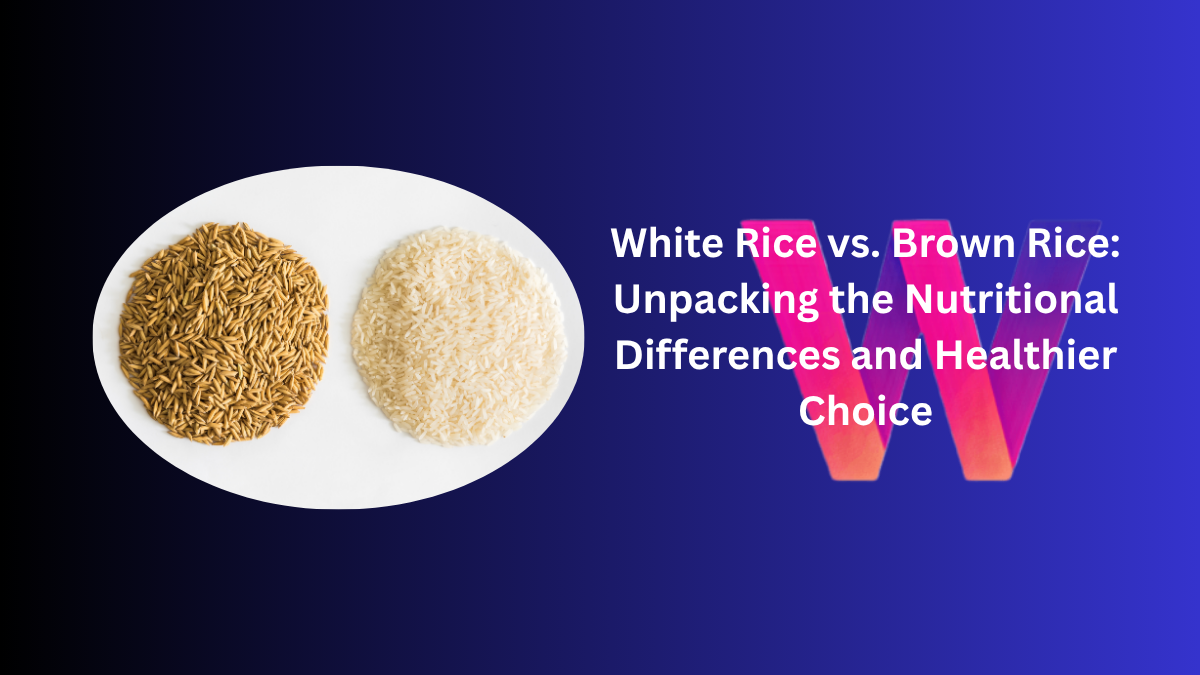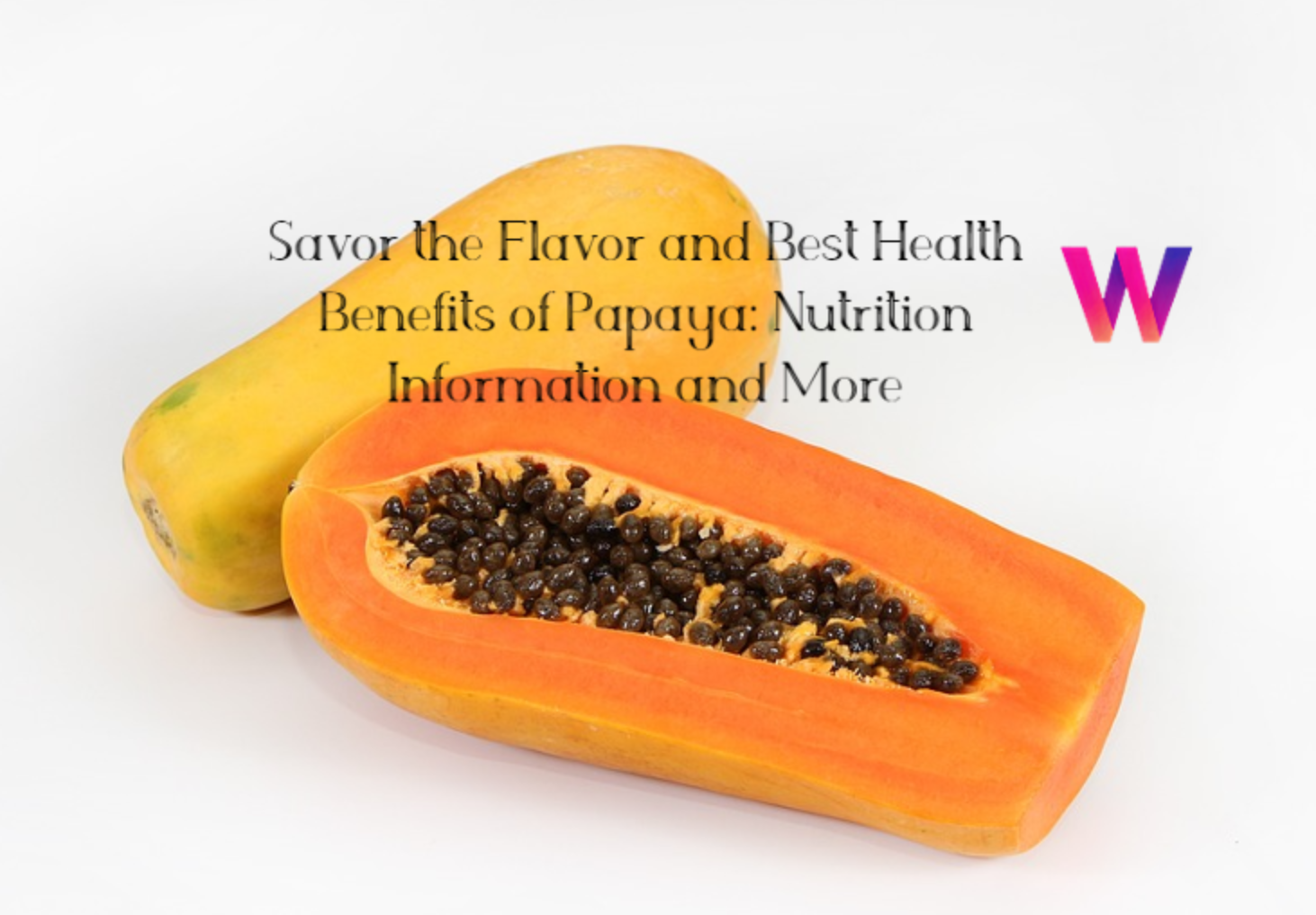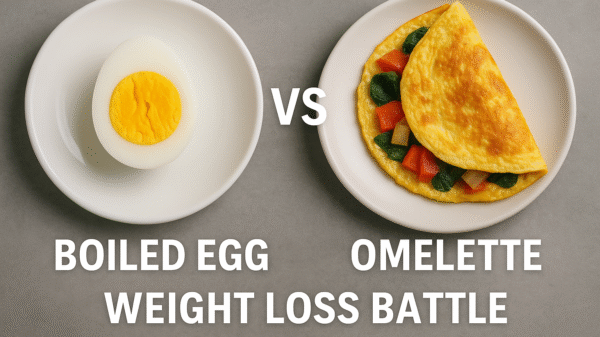Rice stands as a cornerstone of global sustenance, serving as a fundamental food source for over half the world’s population. Its deep integration into diverse culinary traditions, from Asian stir-fries to Latin American side dishes, underscores its widespread importance. Given this pervasive consumption, a thorough understanding of rice’s nutritional nuances becomes paramount for public health and informed dietary choices.
While the common perception often simplifies the choice between “white” and “brown” rice, the reality is far more intricate. A comprehensive examination reveals that the designation of “healthier choice” is not a universal constant but rather a context-dependent assessment. This report aims to transcend superficial comparisons, delving into the scientific distinctions in processing, the resulting nutritional profiles, and their varied health implications. By unpacking the underlying science, this analysis seeks to empower individuals to make dietary decisions that are truly aligned with their specific health goals and physiological needs.
Table of Contents
From Paddy to Plate: Understanding Rice Processing
The journey of rice from a harvested grain to its edible form fundamentally dictates its nutritional composition. The processing methods applied to brown rice versus white rice result in distinct structural and chemical differences.
The Journey of Brown Rice: A Whole Grain
Brown rice is categorized as a whole grain, a designation that signifies it retains all three edible components of the rice kernel: the bran, the germ, and the endosperm. The only part removed during its minimal processing is the inedible outer hull.
The outermost layer, the bran, is a rich reservoir of fiber, B vitamins, and powerful antioxidants. Beneath the bran lies the
germ, which is the embryo of the rice plant. This component is a nutritional powerhouse, contributing a significant array of B vitamins, protein, essential minerals, and healthy fats. Finally, the
endosperm constitutes the largest portion of the kernel. While primarily composed of starchy carbohydrates, it also contains some protein and smaller quantities of vitamins and minerals, serving as the germ’s primary food supply. This complete composition is what gives brown rice its distinct nutritional advantage.
The Transformation to White Rice: Milling, Polishing, and Nutrient Loss
In stark contrast, all white rice originates from brown rice. Its transformation involves an extensive milling and polishing process that meticulously removes the bran and germ layers.
This refining process, while increasing the shelf life and altering the texture and cooking properties of white rice—making it faster to cook and often more palatable for consumers—comes at a significant nutritional cost. The removal of the bran and germ strips away a substantial portion of its inherent nutritional value. This includes a drastic reduction in fiber, B vitamins, and essential minerals such as magnesium, potassium, and manganese. Research indicates that approximately 25% of a grain’s protein and at least seventeen key nutrients are significantly diminished during this refining process. Furthermore, many beneficial phytochemicals and antioxidants naturally present in the outer layers are also lost.
The Role of Enrichment in White Rice
To mitigate the substantial nutrient depletion incurred during milling, white rice is frequently “enriched” or “fortified” with synthetic vitamins and minerals. This typically involves adding back B vitamins such as thiamine, niacin, folic acid (folate), riboflavin, and vitamin B6, along with iron.
However, it is crucial to understand that this enrichment serves as a compensatory measure rather than a full restoration of the original nutritional profile. The process only adds back a fraction of the nutrients that were naturally present in the whole grain. More importantly, fortification does not replace the lost dietary fiber, healthy fats, or the diverse array of other beneficial plant compounds, such as the antioxidants and phytochemicals, that are intrinsic to brown rice. The fundamental alteration of the food matrix through processing means that simple fortification cannot fully replicate the holistic benefits derived from the naturally occurring synergistic nutrients and fiber found in the whole grain. Consequently, while enriched white rice is nutritionally superior to its unenriched counterpart, it remains distinct from brown rice in its comprehensive nutrient density and the presence of protective compounds.
Nutritional Deep Dive: A Side-by-Side Comparison
A detailed examination of the nutritional content reveals significant differences between brown and white rice, particularly in their fiber and micronutrient profiles.
Macronutrients: Calories, Carbohydrates, Protein, and Fat
Both white and brown rice are predominantly carbohydrate-dense foods, serving as efficient sources of energy. They contain relatively small amounts of protein and are virtually devoid of fat or sugar. While their overall macronutrient content is broadly similar, brown rice typically provides slightly more protein, fat, and often calories per serving compared to white rice, though specific calorie data can exhibit variability across different sources and manufacturers.
Fiber: The Unsung Hero of Brown Rice
Dietary fiber is a key differentiator. Brown rice is consistently and significantly higher in dietary fiber than white rice, typically offering an additional 1 to 3 grams of fiber per comparable serving. The bran layer, which remains intact in brown rice, is particularly rich in insoluble fiber, a component crucial for promoting digestive regularity and preventing constipation.
Beyond its well-known role in digestion, fiber confers a multitude of other health benefits. It plays a vital role in weight management by promoting satiety, helping individuals feel fuller faster and for extended periods. Furthermore, fiber is instrumental in lowering cholesterol levels and is a critical factor in controlling blood sugar levels, thereby reducing the risk of diabetes by slowing the absorption of glucose into the bloodstream. Additionally, fiber nourishes beneficial gut bacteria and includes resistant starch, a soluble fiber known to enhance gut health by reducing inflammation and improving gut barrier function.
Micronutrients: Vitamins and Minerals
Brown rice consistently emerges as richer in a broader spectrum of essential micronutrients, a direct consequence of its intact bran and germ layers.
- Manganese: Brown rice is an excellent source of manganese, a mineral indispensable for energy production, antioxidant function, and various metabolic processes. White rice, conversely, is not considered a significant source.
- Magnesium: Brown rice is a good source of magnesium, which is crucial for maintaining energy balance, regulating heart rhythm, supporting bone health, and reducing insulin resistance.
- Selenium: As a good source of selenium, brown rice contributes to thyroid hormone production, antioxidant protection, and robust immune function.
- B Vitamins (Thiamine, Niacin, Vitamin B6, Riboflavin, Pantothenic Acid): Brown rice naturally contains higher levels of these B vitamins, which are vital for metabolism, energy production, and overall physiological well-being. While enriched white rice has some of these vitamins added back, the quantity is often a fraction of what is naturally present in brown rice.
- Phosphorus: Brown rice contains significantly more phosphorus, a mineral essential for bone health.
- Iron & Zinc: Brown rice generally provides more iron and zinc than unenriched white rice. However, it is worth noting that enriched white rice can sometimes exhibit higher iron levels due to fortification efforts.
- Folate (Folic Acid): Enriched white rice is often a good source of folate, a nutrient that plays a critical role in DNA synthesis and is particularly important for women of childbearing age. Brown rice also contains folate.
- Antioxidants & Phytochemicals: Brown rice is a rich repository of beneficial plant compounds, including flavonoids (such as apigenin, quercetin, and luteolin), phenolic compounds, oryzanols, phytosterols, tocotrienols, and lignans. These compounds are instrumental in reducing inflammation, protecting cells from oxidative damage, and consequently lowering the risk of chronic diseases. White rice, due to the removal of its outer layers, largely lacks these protective compounds.
Key Table: Comprehensive Nutritional Comparison (Per 1 Cup Cooked)
The following table provides a side-by-side comparison of the approximate nutritional values for one cup of cooked brown rice versus enriched white rice. These values are approximate and can vary based on the specific rice manufacturer and the extent of enrichment.
| Nutrient (per 1 cup cooked) | Brown Rice | Enriched White Rice | Key Difference/Benefit |
| Calories | 218-238 kcal | 204-242 kcal | Similar, brown slightly higher |
| Carbohydrates | 45.8-49.5 g | 44.2-53.2 g | Both carb-dense, brown often slightly lower |
| Dietary Fiber | 3.12-3.51 g | 0.558-0.6 g | Significantly higher in brown rice (5-6x more) |
| Protein | 4.52-5.32 g | 4.22-4.43 g | Slightly higher in brown rice |
| Total Fat | 1.62-1.87 g | 0.15-0.4 g | Higher in brown rice (healthy fats from germ) |
| Magnesium | 85.8 mg | 24.2 mg | Significantly higher in brown rice |
| Manganese | 2.14 mg | 0.071 mg | Vastly higher in brown rice (30x more) |
| Phosphorus | 150 mg | 68.8 mg | Higher in brown rice |
| Iron | 1.03 mg | 2.77 mg | Enriched white rice can be higher due to fortification |
| Thiamine (Vit B1) | 0.199 mg | 0.311 mg | Enriched white rice can be higher due to fortification |
| Niacin (Vit B3) | 2.59 mg | 3.42 mg | Enriched white rice can be higher due to fortification |
| Vitamin B6 | 0.291 mg | 0.093 mg | Higher in brown rice |
This table visually underscores the profound nutritional advantages of brown rice, particularly in its fiber, magnesium, manganese, and phosphorus content. While enriched white rice may sometimes show higher levels of specific fortified nutrients like iron and certain B vitamins, it fundamentally lacks the comprehensive spectrum of naturally occurring vitamins, minerals, healthy fats, and protective plant compounds found in brown rice.
Health Implications: Beyond the Numbers
The nutritional disparities between white and brown rice translate into significant differences in their impact on various aspects of human health, from metabolic regulation to chronic disease prevention.
Blood Sugar Management: Glycemic Index (GI) and Glycemic Load (GL) Explained
The Glycemic Index (GI) is a crucial measure that quantifies how rapidly a food elevates blood sugar levels after consumption. White rice typically exhibits a high GI, ranging from 64 to 89, indicating that its carbohydrates are quickly broken down and absorbed into the bloodstream. This rapid absorption leads to quick and sharp spikes in blood glucose, with levels potentially exceeding 10 mmol/L.
In contrast, brown rice possesses a lower to moderate GI, generally falling between 50 and 55. This characteristic results in a slower and more gradual release of glucose into the bloodstream, which helps to maintain more stable blood sugar levels, typically staying below 8 mmol/L. The primary mechanism behind this beneficial effect is the significantly higher fiber content in brown rice, which slows down the digestive process and the absorption of carbohydrates.
The implications for long-term health are substantial. Consistently high blood sugar spikes, often associated with regular consumption of high-GI foods like white rice, can contribute to the development of insulin resistance, a precursor to Type 2 Diabetes. Numerous studies have established a link between higher white rice intake and an increased risk of Type 2 Diabetes, with some research indicating an 11% increased risk per daily serving. Conversely, a greater consumption of brown rice is associated with a reduced risk of this condition. While the general trend strongly favors brown rice for blood sugar management, it is important to acknowledge that individual physiological responses to food can vary. Some reviews have noted mixed research findings on the precise significance of brown rice’s effect on blood sugar control in individuals already managing pre-diabetes or Type 2 Diabetes. This highlights that even brown rice, as a carbohydrate, can still elevate blood sugar if consumed in excessively large quantities, underscoring the ongoing importance of portion control as part of a balanced diet.
Weight Management and Satiety: The Role of Fiber and Protein
The elevated fiber and protein content inherent in brown rice contribute significantly to enhanced satiety. This means individuals tend to feel fuller more quickly and for longer durations after consuming brown rice. This sustained feeling of fullness is a valuable asset in weight management, as it can naturally lead to a reduction in overall calorie intake and help prevent overeating. Research has indeed correlated brown rice consumption with healthier body weight, a reduction in body mass index (BMI), and a decrease in waist circumference.
Cardiovascular Health and Chronic Disease Prevention
Whole grains, including brown rice, are consistently associated with a lower risk of serious chronic conditions such as stroke, heart disease, and Type 2 Diabetes. The fiber present in brown rice plays a crucial role in reducing cholesterol levels, a well-established factor in maintaining heart health.
Beyond fiber, brown rice contains specific plant compounds, such as lignans, which have demonstrated abilities to lower blood pressure, reduce the amount of fat in the blood, and decrease arterial stiffness, all contributing to improved cardiovascular health. Furthermore, the flavonoid antioxidants and phenolic compounds abundantly found in brown rice are critical in disease prevention. These compounds actively work to reduce inflammation and neutralize free radicals, thereby potentially lowering the risk of various chronic conditions, including certain cancers.
While the vast majority of evidence points to the benefits of whole grains for chronic disease prevention, it is important to acknowledge that some systematic reviews have not found a reduced risk of stroke, heart disease, or cancer specifically from intakes of either white or brown rice. This particular finding, however, stands in contrast to the broader body of research that supports the protective role of whole grains. The preponderance of evidence from numerous reputable sources generally supports the inclusion of whole grains like brown rice in a diet aimed at reducing the risk of chronic diseases. This highlights the ongoing nature of scientific inquiry and the importance of considering the collective weight of evidence.
Digestive Health: Fiber’s Benefits and White Rice’s Niche
For the majority of individuals, the rich fiber content in brown rice actively promotes a healthy and regularly functioning digestive system. However, there are specific scenarios where white rice may be the more appropriate choice. For individuals experiencing certain digestive issues or possessing sensitive stomachs, such as those diagnosed with inflammatory bowel diseases (IBD) like Crohn’s disease or ulcerative colitis, or those recovering from bowel surgery, white rice’s lower fiber and residue content makes it significantly easier to digest. In these cases, the reduced digestive burden of white rice can be a considerable advantage.
Metabolic Syndrome and Overall Well-being
Elevated intakes of white rice, particularly when consumed in large quantities, have been associated with an increased risk of metabolic syndrome. This syndrome is characterized by a cluster of risk factors including high blood pressure, elevated fasting blood sugar, high triglyceride levels, a large waistline, and low levels of “good” HDL cholesterol, all of which collectively increase the risk of heart disease, Type 2 Diabetes, and stroke. Conversely, brown rice consumption has been shown to actively support and improve metabolic health.
Navigating the Nuances: Potential Concerns and Considerations
While brown rice offers a clear nutritional advantage in many areas, a comprehensive assessment necessitates addressing certain potential concerns and specific scenarios where white rice might be preferred.
Arsenic Content: Understanding the Risk and Mitigation Strategies
A notable concern associated with brown rice is its higher propensity to accumulate arsenic, a substance recognized for its carcinogenic and mutagenic properties. Studies indicate that brown rice typically contains arsenic levels approximately 1.5 times higher than those found in white rice, with some research reporting levels 72.2% to 98.3% greater. This difference arises because arsenic tends to concentrate in the outer bran and husk layers, which are retained in brown rice but removed during the processing of white rice.
Chronic, long-term exposure to even low levels of arsenic has been linked to a range of adverse health outcomes, including various types of cancer (such as skin, lung, and bladder), cardiovascular disease, and an elevated risk of diabetes. This presents a crucial consideration for consumers: balancing the greater nutritional benefits of brown rice against the potential for higher arsenic exposure. The determination of the “healthier choice” in this context becomes individualized, dependent on factors such as consumption frequency, the origin of the rice, and the implementation of mitigation strategies.
To minimize arsenic exposure from rice, several practical strategies can be employed:
- Rinsing: Thoroughly rinsing rice before cooking can effectively remove approximately half of its arsenic content.
- Cooking Method: Adopting a “pasta-like” cooking method—using six times as much water as rice and draining the excess water after cooking—can reduce arsenic levels by about half. However, the efficacy of this method may be compromised, or even reversed, in regions where the cooking water itself contains high levels of arsenic.
- Source Awareness: Selecting rice from regions known for lower arsenic levels is advisable. Examples include white basmati rice from California, India, and Pakistan, or sushi rice from the U.S.. For brown rice, basmati varieties from these same regions are also recommended for lower arsenic content.
- Dietary Diversity: Diversifying grain intake by incorporating other lower-arsenic whole grains such as amaranth, bulgur, millet, quinoa, and wheat berries can significantly reduce overall exposure to arsenic.
- Consumption Frequency: While occasional consumption is generally not a concern for acute poisoning, some experts suggest limiting brown rice intake to no more than four times a week if arsenic exposure is a particular worry.
- Special Populations: Young children, who typically consume more rice per unit of body weight, are considered more vulnerable to arsenic toxicity. Regulatory bodies, such as the FDA, have established action levels for inorganic arsenic in infant rice cereal to address this concern.
Antinutrients (Phytic Acid): Impact on Mineral Absorption and Mitigation
Brown rice contains phytic acid, also known as phytate, an antioxidant predominantly concentrated in its outer bran layers. Phytic acid is sometimes referred to as an “antinutrient” because humans lack the phytase enzyme necessary to break it down. Consequently, when consumed alongside foods rich in minerals, phytic acid can bind to essential minerals such as iron, zinc, magnesium, and calcium, potentially decreasing their absorption in the intestine during the same meal.
However, a more nuanced understanding reveals that phytic acid possesses a dual nature, offering significant health benefits alongside its mineral-binding properties. It exhibits potent antioxidant properties and has been shown in laboratory and animal studies to protect against DNA damage and inhibit cancer cell growth. Furthermore, phytic acid can contribute to improved metabolic health by lowering cholesterol, slowing digestion, preventing sharp rises in blood sugar, and even inhibiting the formation of kidney stones by preventing calcium crystal buildup. For most individuals consuming a varied diet, the mineral-binding effect of phytic acid is unlikely to lead to clinically significant deficiencies.
For those concerned about mineral absorption or with specific deficiencies, several mitigation strategies can be employed: soaking, sprouting (germination), fermenting, or boiling brown rice prior to cooking can help break down phytic acid, thereby enhancing mineral bioavailability. Due to its processing, white rice contains considerably lower levels of phytic acid.
When White Rice Might Be the Preferred Choice
Despite brown rice’s general nutritional superiority, white rice retains specific advantages that make it the preferred choice in certain situations:
- Digestive Sensitivities: As previously discussed, white rice is easier to digest for individuals with inflammatory bowel disease, those recovering from bowel surgery, or those adhering to a low-fiber diet. Its low residue content makes it gentler on a compromised digestive system.
- Post-Workout Recovery: For athletes or individuals engaged in intense physical activity, white rice offers fast-digesting carbohydrates. This makes it an efficient option for rapidly replenishing muscle glycogen stores and accelerating recovery after strenuous exercise.
- Lower Arsenic Exposure: For individuals who consume rice frequently or in large quantities, or for vulnerable populations such as young children, choosing white rice can significantly reduce overall dietary arsenic exposure.
- Culinary Preference: Ultimately, personal preference plays a role. Some individuals simply prefer the neutral flavor and delicate, softer texture of white rice, making it a more enjoyable component of their diet.
Culinary Perspectives: Taste, Texture, and Versatility
Beyond nutritional content, the culinary attributes of white and brown rice—including their cooking characteristics, flavor profiles, and textural differences—significantly influence their appeal and application in diverse cuisines.
Cooking Times and Preparation Differences
A primary distinction lies in their cooking requirements. Brown rice, with its intact bran layer, generally demands more water and a considerably longer cooking time compared to white rice. White rice, conversely, cooks more quickly, offering a faster preparation time. For brown rice, rinsing thoroughly before cooking is often recommended to remove excess starch and prevent stickiness, contributing to a more desirable texture. Achieving optimal texture for brown rice also involves proper cooking techniques, such as adhering to the correct water-to-rice ratio (typically 2:1 for brown rice) and allowing the cooked rice to rest, covered, for several minutes after cooking.
Flavor Profiles and Textural Contrasts
The processing differences also impart distinct sensory qualities:
- Brown Rice: Characterized by a chewier, firmer texture and a pronounced nutty flavor. Specific varieties offer unique nuances; Basmati brown rice, for instance, presents a lighter nutty flavor and a firmer cooked texture, making it ideal for dishes where grains should remain separate. Jasmine brown rice, another long-grain variety, is celebrated for its sweeter aroma and slightly sticky, nutty texture, making it versatile across a range of flavors. Short-grain brown rice is notable for its plump grains and satisfyingly chewy consistency.
- White Rice: Possesses a more neutral, delicate flavor and a softer, fluffier texture. Its relative blandness is often considered a culinary advantage, as it readily absorbs and complements the flavors of other ingredients in a dish.
Versatility in Various Cuisines and Dishes
Both types of rice are remarkably versatile and serve as fundamental staples in countless global cuisines.
- Brown Rice: Can often be used interchangeably with white rice in a wide array of recipes, lending itself particularly well to hearty dishes, salads, and grain bowls. Culinary applications include brown rice cakes, lentil brown rice soup, brown rice burrito bowls, veggie brown rice sushi, and even creamy brown rice pudding. Its inherent texture and richer flavor can add depth to meals.
- White Rice: Its neutral profile and soft texture make it exceptionally adaptable, ideal for absorbing sauces and flavors in stir-fries, pilafs, and as a light, fluffy side dish. Specific varieties like Jasmine and Arborio are prized for their unique cooking properties and are central to particular culinary traditions.
Expert Recommendations: Guidance from Health Organizations
Leading health organizations consistently provide guidance on grain consumption, with a clear emphasis on the benefits of whole grains like brown rice.
USDA Dietary Guidelines (MyPlate)
The U.S. Department of Agriculture (USDA), through its MyPlate initiative, strongly advocates for the inclusion of grains as a key food group in a balanced diet. A core recommendation is that at least half of the grains consumed daily should be whole grains. Brown rice is explicitly cited as an exemplary whole grain within these guidelines. The daily recommended intake of grains varies based on an individual’s age, sex, height, weight, and physical activity level, with a serving equivalent to 1/2 cup of cooked rice counting as one ounce-equivalent of grains.
American Heart Association (AHA) Recommendations
The American Heart Association (AHA) robustly recommends incorporating whole-grain foods that are rich in fiber and essential nutrients, explicitly listing brown rice as a preferred choice for cardiovascular health. The AHA advises adults to aim for a daily fiber intake of 22 to 34 grams, highlighting that brown rice contributes significantly more fiber per serving than white rice. Their guidelines suggest consuming approximately 6 ounce-equivalents of whole grains daily.
American Diabetes Association (ADA) Advice
For individuals focused on blood sugar management, the American Diabetes Association (ADA) advises prioritizing whole grains such as brown rice or quinoa, emphasizing their rich content of vitamins, minerals, and fiber. The ADA’s “plate method” recommends dedicating 25% of a meal plate to healthy carbohydrates, with whole grains like brown rice being a prime example. Furthermore, the ADA counsels against excessive intake of refined carbohydrate foods, such as white rice, to help effectively manage blood sugar levels.
The consistent and unified message from these prominent health organizations underscores a broad scientific consensus regarding the superior health benefits of whole grains, including brown rice, over refined grains. This widespread endorsement is rooted in the comprehensive nutritional profile of whole grains, particularly their fiber, nutrient, and phytochemical content. This collective recommendation reinforces the general conclusion that brown rice represents the nutritionally superior choice for the majority of the population aiming to optimize their health.
Conclusion: White Rice Vs Brown Rice Making Your Healthier Choice
The comprehensive analysis of white rice versus brown rice reveals clear distinctions in their nutritional profiles and subsequent health implications. Brown rice, as a whole grain, consistently offers a superior nutritional composition. It boasts significantly higher levels of dietary fiber, a broader spectrum of essential B-complex vitamins, and a richer concentration of vital minerals such as magnesium, manganese, selenium, and phosphorus. Furthermore, it retains a wealth of beneficial plant compounds, including powerful antioxidants, lignans, and flavonoids, which are largely absent in white rice.
These nutritional advantages translate into substantial health benefits for brown rice consumers. These benefits include more effective blood sugar management due to its lower glycemic index, improved weight control through enhanced satiety, better digestive health, and a reduced risk of chronic diseases such as Type 2 Diabetes and heart disease.
However, it is equally important to acknowledge that white rice is not without its merits and can serve a valuable role in specific dietary contexts. Its refined nature makes it easier to digest for individuals with sensitive stomachs or certain digestive conditions. It also provides a source of fast-digesting energy, making it a suitable option for specific needs, such as post-workout recovery. Additionally, white rice typically contains lower levels of arsenic, a consideration for individuals with high rice consumption or vulnerable populations.
Ultimately, the determination of the “healthier choice” is not an absolute judgment but rather a nuanced decision influenced by individual health goals, specific dietary needs, existing digestive sensitivities, and even personal culinary preferences. For the majority of the population, incorporating brown rice as a dietary staple aligns with the consistent recommendations from authoritative health organizations such as the USDA, American Heart Association, and American Diabetes Association, all of whom advocate for whole grains comprising at least half of one’s daily grain intake.
For those who prefer white rice or have specific physiological requirements, it can certainly be integrated into a healthy diet. Regardless of the type chosen, it is paramount that rice be consumed in moderation and as an integral component of a well-balanced meal. Pairing rice with lean protein sources, a diverse array of vegetables, and healthy fats is crucial for optimizing its nutritional impact, mitigating potential blood sugar spikes, and ensuring a comprehensive intake of essential nutrients. This holistic approach to meal composition emphasizes that optimal nutrition extends beyond the isolated choice of a single ingredient, focusing instead on the synergistic effect of all components within a meal and across the entire dietary pattern.











